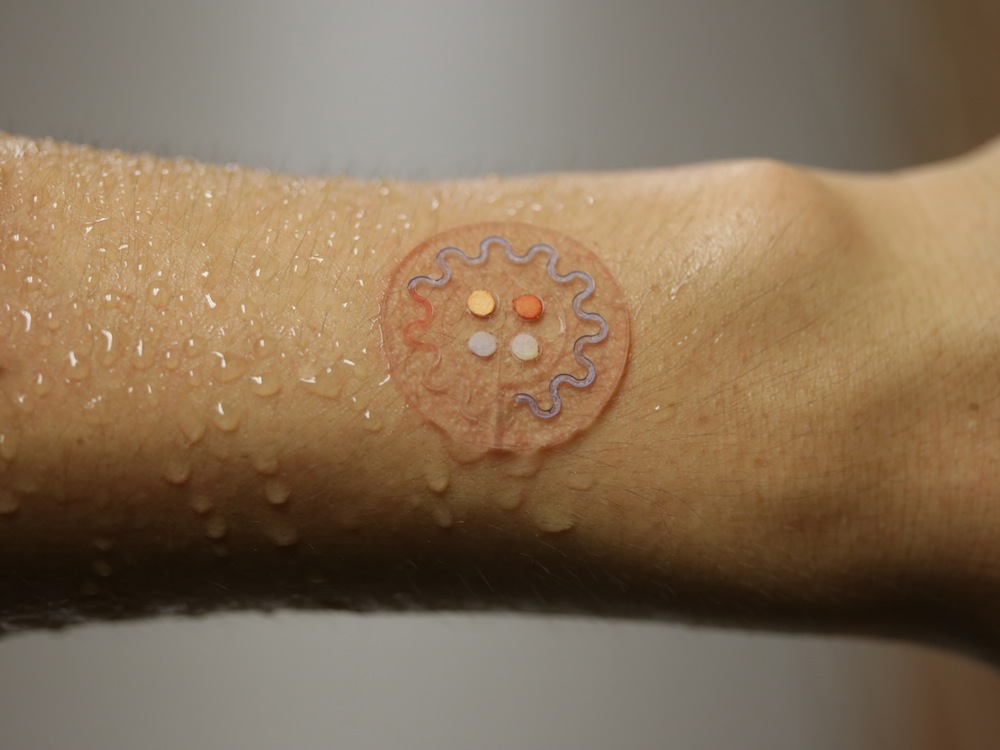Sweat Detectors? Tiny Sensors Use Perspiration to Track Health


Imagine if taking a snapshot of your health were as easy as slapping a sticker on your skin. A new study finds that a tiny adhesive sensor can read what's going on in your body based on your sweat, and relay information about your well-being wirelessly to a smartphone. This type of wearable sensor could work as an alternative to blood tests to assess people's health one day, according to the researchers.
Perspiration is a rich chemical full of molecules ranging from simple electrically charged ions to more complex proteins that can shed light on what is happening inside the human body. Doctors can use sweat to diagnose certain diseases, uncover drug use and reveal insight into athletic performance. Sweat also can be gathered far less invasively than blood, said study senior author John Rogers, a materials scientist and director of Northwestern University's Center for Bio-Integrated Electronics in Evanston, Illinois.
In the new study, scientists embedded chemical sensors and other devices into a soft, flexible silicone rubber disc, about the size and thickness of a quarter, that can easily stick to skin. The device is designed to collect and analyze sweat for key biomarkers, or markers of health. For instance, the sensor can show how people are responding to exercise, including whether someone needs to make adjustments, such as drinking more water or replenishing electrolytes. [Bionic Humans: Top 10 Technologies]
"We've been developing various thin, soft and flexible skin-mounted devices as a next-generation platform for wearable technologies for a few years now," Rogers told Live Science. "Now, we've developed such a device to capture and analyze sweat."
This wearable lab contains "microfluidics" designed to route fluids inside themselves in much the same way that microelectronics do with electrons. Specifically, the sensor directs sweat down a number of microscopic channels that are about 0.02 inches (0.5 millimeters) wide into compartments about 0.16 inches (4 mm) in diameter. Each of these chambers measures specific biomarkers, such as pH, lactate, chloride and glucose levels.
"We chose these four biomarkers because they provide a characteristic profile that's relevant for health-status determination," Rogers said in a statement. "The device also can determine sweat rate and loss, and it can store samples for subsequent laboratory analysis, if necessary."
Chemical reactions within the sensor's compartments result in visible changes in color that reveal what levels of a given biomarker are present in the sweat. When a smartphone is brought near the sensor, near-field communications technology within the smartphone — the same kind used in mobile payment systems such as Google Wallet and Apple Pay — use short-range radio waves to power and talk to electronics within the sensor. Then, the electronics in the sensor cause a smartphone app to take a photo of the sensor, and the app can then analyze this image to calculate biomarker levels, the researchers said.
Get the world’s most fascinating discoveries delivered straight to your inbox.
"The sweat analysis platform we developed will allow people to monitor their health on the spot without the need for a blood sampling and with integrated electronics that do not require a battery but still enable wireless connection to a smartphone," study co-author Yonggang Huang, a professor of engineering at Northwestern University, said in a statement.
Conventional methods of analyzing sweat capture perspiration with absorbent patches taped to the skin and analyze them later, off-site. In contrast, the new sensor can analyze sweat in real time, Rogers said.
Sweat sensors that other scientists have developed can be worn on the skin. But these other sensors still rely on absorbent patches as opposed to microfluidic channels, so they do not analyze the rate at which people sweat, Rogers said. Moreover, unlike previous sweat sensors, the new device does not require batteries, he added.
In experiments, Rogers, Huang and their colleagues placed their sensor on the forearms and backs of 21 healthy volunteers to analyze their sweat. Nine of the participants cycled indoors in a fitness center under controlled conditions, while the other 12 took part in the El Tour de Tucson, a long-distance bicycle race in arid and complex outdoor conditions.
The data from the sensors that the indoor cyclists wore reliably matched those from conventional methods of analyzing their sweat, according to the scientists. The sensors on the outdoor cyclists also performed as expected, and stayed on despite the complex and unpredictable conditions of the desert. In addition, the devices stayed on all the volunteers without causing discomfort or irritation, the researchers said.
The aim is for the sensors "to come in less than $1.50 per device," Rogers said. "At that price point, we think they can reasonably find application for one-time use."
In terms of immediate commercial applications, the scientists said they "can see this device used in fitness, wellness and exercise — for instance, for athletes to track sweat rate and electrolyte loss," Rogers said. "We're also working with a large biomedical device company to use these to noninvasively track glucose in sweat in the context of diabetes," he added. "We're also working with the U.S. Air Force to track the health states of active-duty airmen."
The researchers added that that their technology could potentially extend to other bodily fluids, such as tears and saliva. The scientists detailed their findings online Nov. 23 in the journal Science Translational Medicine.
Original article on Live Science.



